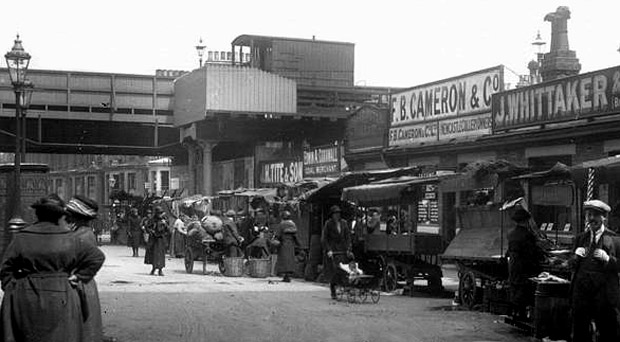
Back in the late Victorian period, railway magnate Sir Edward Watkin decided what London really needed was a massive tower to eclipse the famous Eiffel Tower in Paris.
Watkin opened up the design to public competition, and thanks to the rather excellent Public Domain Review it’s now possible to view the kind of weird and wonderful landmarks designers had in mind for London – including some entries from south Londoners.

[Brixton’s Philip E Massey proposed a 1,400 ft tall cast iron tower featuring Roman elements, flower beds and fountains, with 400 rooms for rent. This ambitious creation would have been considerably taller than the The Shard which only tops out at 1,017 ft)]
A bit of background
Watkin – never a man to think small – was already working on his grand vision of a trans-European railway linking Sheffield, Manchester and Leeds to the Continent via a Channel Tunnel, and he hoped the tower would help draw tourists to his rail network.
The new tower was intended to be the centrepiece of a pleasure park just 12 minutes from Baker Street station, and Watkin first invited Gustave Eiffel to come up with a design, but he declined, commenting that if he designed the tower, the French people “would not think me so good a Frenchman as I hope I am.”

[Design No 43 was dreamt up in Stoockwell Road, SW9, and envisioned a 1,200 ft tower made entirely out of concrete]
Watkin decided hold an architectural competition in 1890, and invited entries from all around the world.
No less than 68 designs were submitted, many showing off the full reign of imagination, ambition and, in some cases, sheer madness of the white heat of the Victorian age.

[From the leafy suburbs of East Dulwich came this 1,260 foot tall Victorian Gothic invention, hewn from iron and steel]
Some designs were just plain bonkers – one tower would have been nearly twice the height of The Shard and was to feature a steam train precariously spiralling upwards around the outside.
Several designers played it safe, basing their entries on the tried and trusted Eiffel Tower, while others drew inspiration from further afield, submitting towers influenced by ancient monuments like the Leaning Tower of Pisa and the Great Pyramid of Giza.

[Another East Dulwich design, this time by the intriguingly named Thos. V Trew, this tower was to feature restaurants and promenades, with room around the base for bazaars and boiler sheds]
Several south Londoners also pitched in for the work too, although all of them were unsuccessful, with the design submitted by Stewart, MacLaren and Dunn eventually proving the winner.
Compared to some of the madcap schemes on offer, their tower was a relatively modest affair, standing on eight legs and set to rise to 358 metres (1,240 ft) – 43m higher than its French rival.

The winning design was to stand 1,200ft tall and cost £350k to build. Claimed to have an Oriental character, the tower would incorporate a hotel with 90 bedrooms and a large central hall.

The tower was also to include two observation decks, each containing attractions such as restaurants, theatres, dancing rooms, exhibitions, and Turkish baths.
Tasked with erecting the tower was The Metropolitan Tower Construction Company, who laid the foundations in 1892 and started construction the next year.

By 1896, the tower had not progressed further than 47 metres (154ft). Problems with the structure’s foundations meant that the number of legs was reduced to just 4 – a decision that would lead to subsidence caused by the increased pressure.
Financial problems led to the construction company going into liquidation in 1899. Work was then stopped on the project and was never started again, with Watkin’s death in 1901 putting an end to the dream.

By now known as ‘Watkins Folly,’ the constructed part of the tower was flattened by dynamite between 1904 to 1907.
Although long forgotten by most, a little bit of the tower resurfaced fairly recently, as this Wikipedia page reports:
The original Wembley Stadium was built for the 1923 British Empire Exhibition on the site of the tower, covering its foundations. When the stadium was rebuilt in 2000, the lowering of the level of the pitch resulted in the concrete foundations of the tower being rediscovered on the stadium site

You can view all the designs here, but here’s two of my favourites:

[Standing nearly twice as tall as The Shard, this wildly ambitious circular tower was intended to be a ” Monument of Hieroglyphics emblematic of British History during Queen Victoria’s Reign,” and would feature a steam railway puffing half way up the spiral gradient. Cost for the full version was set at over £1m – a staggeringly high sum of money]

[It’s not hard to see where J Horton of Halifax may have got his inspiration for this £400k tower that was to feature a spiral promenade and a spiral road for tramcars that would ascend half way up the tower. There was also a Telescopic Lift which was only intended to be used in ‘calm weather’]
More links about the tower:
See all 68 designs in the Public Domain Review
The Infernal Tower
Tale of Two Towers: the Fabulous Folly of Edward Watkin
Watkin’s Tower
12 Massive Towers That Might Have Been Built At Wembley
Tower location
*Thanks to the Londonist for spotting this.











































































































































































